Half-free morels are edible and technically true morels. They're just smaller and more fragile. If you're a morel hunter they're a species you should know.
A couple years ago I put a post up called "legend of the peckerhead morel". My friend and I were more than a little pissed off after catching someone rummaging around our patch picking the teeniest tiniest morels, saying that they were known as peckerheads, and that they were good eatin'.
One of the things I said in the post was that there absolutely, positively, wasn't such a thing as a peckerhead mushroom, and like it or not, I was only half-right.
Peckerhead Mushrooms
Turns out there is a mushroom colloquially known as the peckerhead morel (they may also be called "dog peckers"-a hilarious common name if there ever was one) but, it isn't a morel as you and I know them.
Hidden in here somewhere is the problem between the specificity of Latin names, and the wide, approachable net cast by common names, but I'm going to try and avoid that.
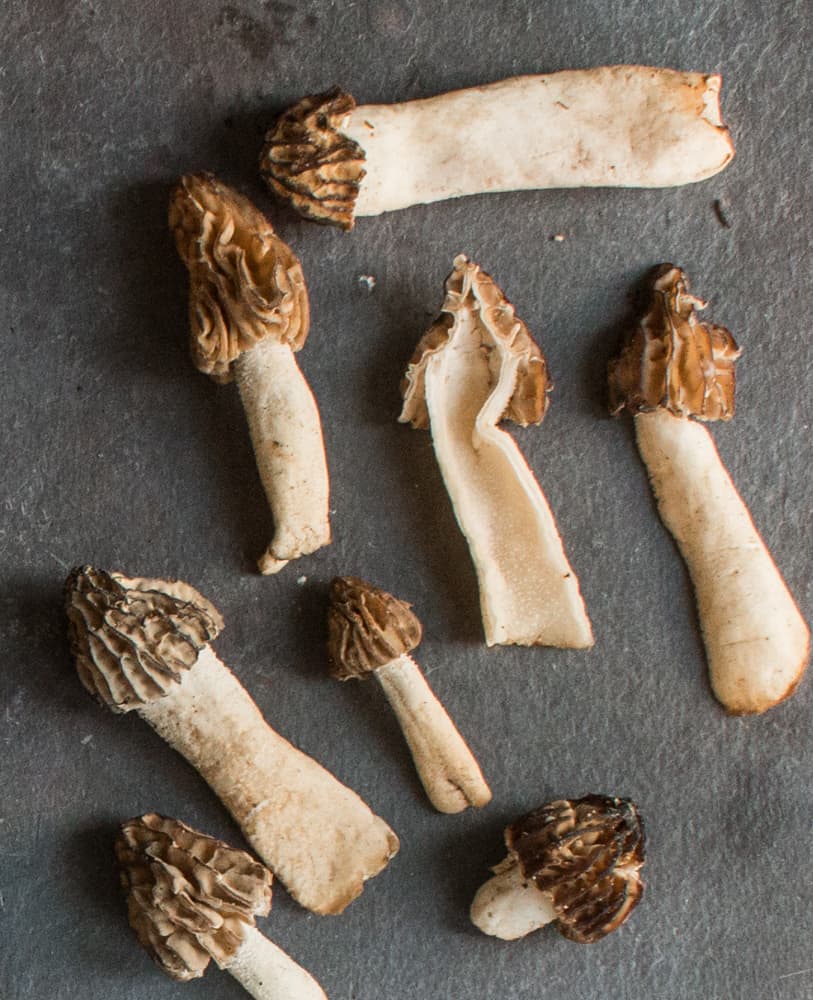
Note how the cap is connected half-way to the stem.
General Info and Observations
The ol' peckerhead mushroom, as far as I can tell, refers to Morchella punctipes, and populiphila, or what used to be known under the larger umbrella term as Morchella semilebera, which is now, reserved only to species picked in Europe. With their similar shape, a related mushroom called Verpa bohemica likely gets lumped in there too.
Either way, the above morchella names (excluding Verpas) refer to a common name that's actually useful to a degree: the half-free morel. The half-free refers to the fact that the stem is connected to the cap at the top, giving the mushroom a sort of cape looking appearance when cut in half.
Sporadic fruiting
One thing I've learned over the years that other hunters have noticed as well is that each year is different with these. Some years I may not see any in a patch, the next year, for whatever reason (rain, temperature, etc) they may seem to be everywhere.
An Indicator species
Whether you find enough to take home and cook or not, one thing that's for certain is that when you see these mushrooms, or other mushrooms that are morel look-a-likes, you're in the right habitat. If I see a half free on the side of the trail or in the woods, I stop walking and scour the area for the real deal.
Half-Free Morels are True Morels
Common morels I pick are typically elm-associate "common" Morchella americana. Half-free morels, like we covered above, could be Morchella punctipes, or others depending on where you live. So, what does that mean? It means they're both morchellacae--the same family, so half-free morels and common morels are both morels, just a little different.
Verpa bohemica, on the other hand, is not as closely related, so its placed in the genus Verpa, instead of Morchella. Just another reason Latin names are a powerful, educational tool.

Note the half-connected cap/stem combo. Verpas will have a cap that is completely free.
Identification
Getting to point here, the real nugget of info in this post is this: how do you tell the difference between half-free morels and Verpa bohemica? And relating to that, why is it important?
It's always good to know exactly what you're eating when you eat wild mushrooms, secondly, Verpas can cause gastro-intestinal upset in some people, but then again, so can morels.
That being said, the toxicology of Verpa's is also the same as morels, and they shouldn't be regarded as dangerous, just different. Here's the key differences as I see them:
Half-free morels vs Verpa bohemica
- Half free morels have a cap that is literally connected at a "half-way point" to the stem. Verpa caps are completely loose and only connected to the stem at the very top.
- Half free morels are hollow inside, where Verpas will often have cottony pith inside their stem, resembling Gyromitra species.
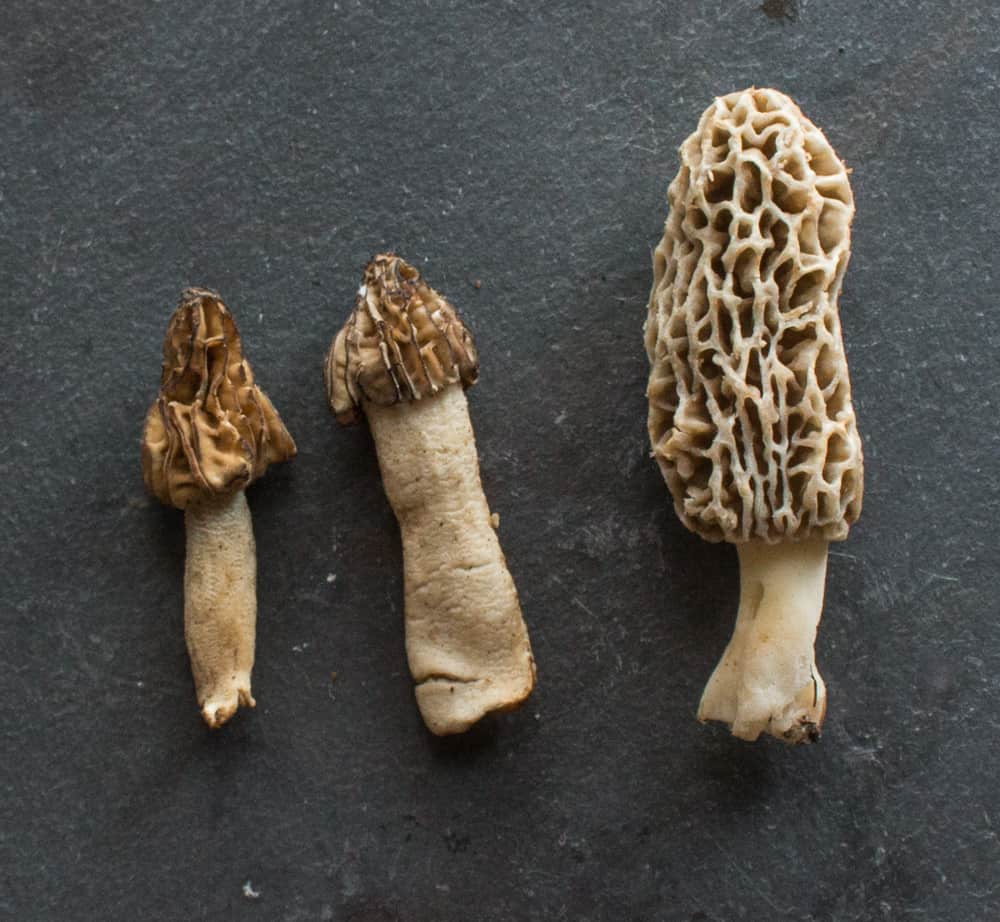
Even if you're brand new to mushroom hunting you should be able to pick out some differences here. On the right is a common morel, on the left, two half-frees.
Half-free morels vs common morels
- Common morels will be bigger, sturdier, and hefty. Half-free morels will generally be very fragile, and crumbly, especially in the stems, which are noticeably longer respectively to true morels.
- True morel mushrooms have no separation between cap and stem, half free morels, as mentioned above, have a bit of separation between cap and stem, but not as much as Verpas.
Cooking
Since half frees are a true type of morel they're fine to eat. I can tell you that I ate every single one of the half-free morels pictured here, in varying amounts, over the span of a week and had absolutely no issues, in fact, they were really good.
Texture wise they aren't the equal of true, meaty morels and are much more brittle and liable to become crumbs if you put common morels in with them, but, if you find some, try them-they're still technically morels, after all.
If, for some reason you've found enough mushrooms to cook, which can be difficult as they're much more brittle than common morels, you can cook them up as you would any other mushroom, just make sure to cook them thoroughly.
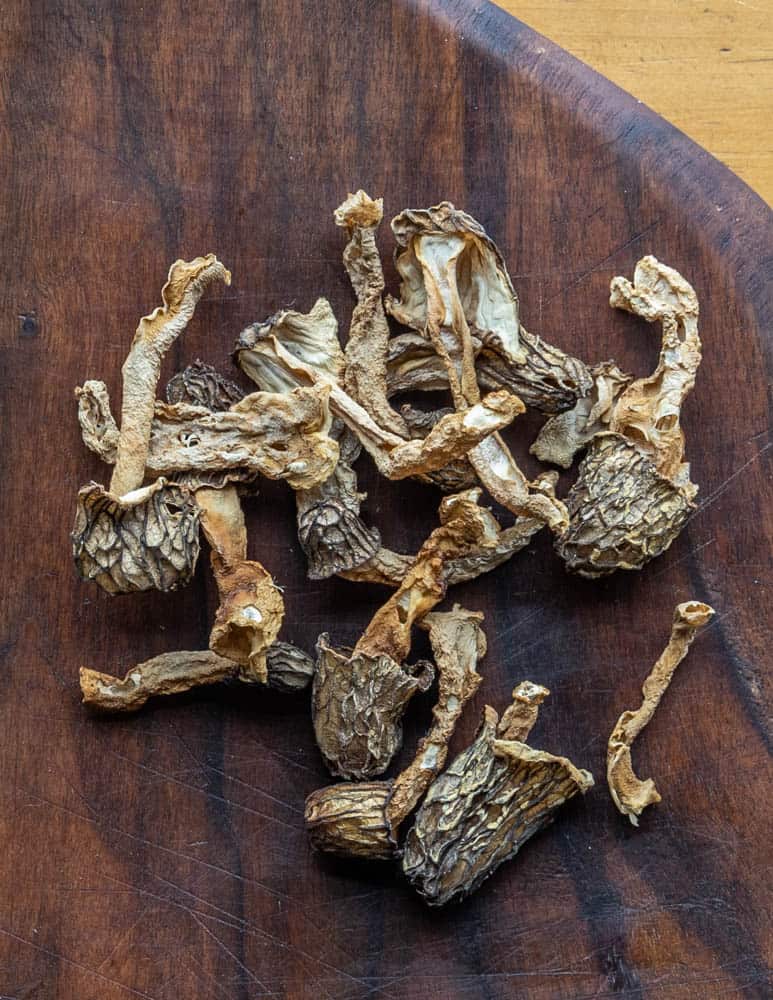
Dried half-free morels won't be as brittle as the fresh mushrooms.
Since they're so brittle, and I can end up with only a few handfuls at a time, I typically dehydrate mine and toss some in with dried morels when I'm using them in a recipe. Just like their more famous cousins, they're good in soup and sauces, and love dairy, especially a splash of cream.
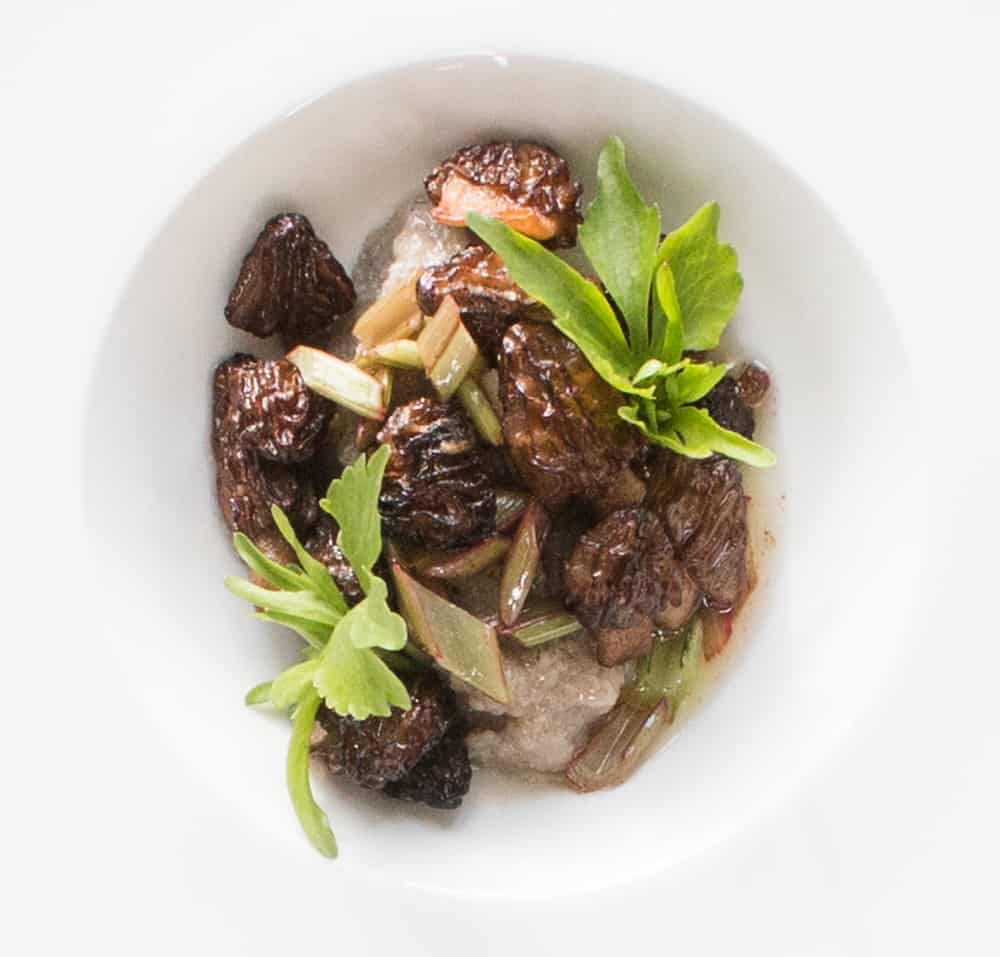
With sochan and wild rice polenta.
Lastly, big thanks to my friend Alex for hooking me up with the mushrooms pictured here. She does forays around the Twin Cities and is a talented mushroom hunter. Hit her up or follow her Facebook page for updates.

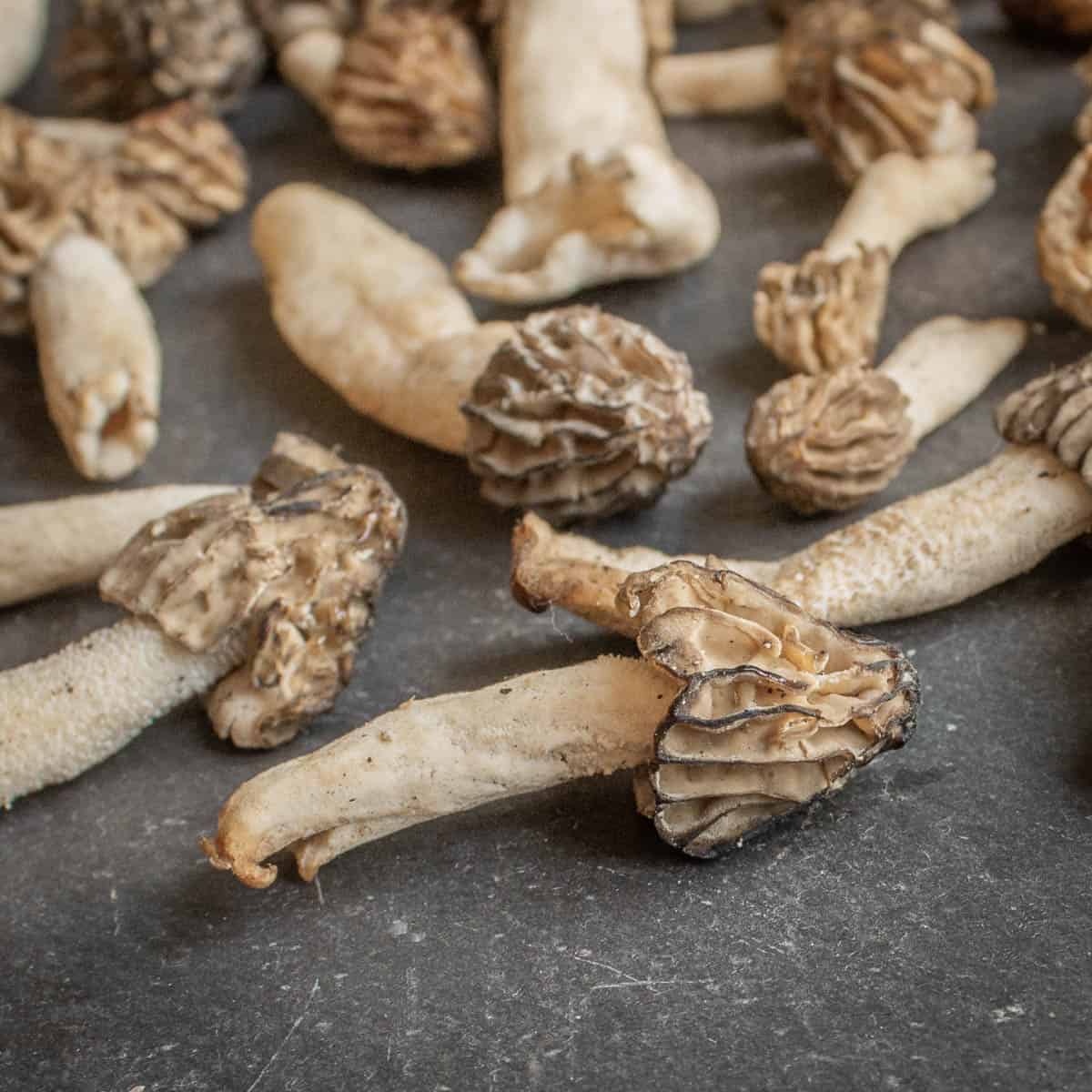
Chris
I used to live in Ohio and hunted sponge and black top mushrooms. Now that I live in Florida, where can I purchase freshly hunted mushrooms? Thank you in advance.
Anne Knaggs
I've enjoyed you info. I am going crazy hearing about the Bumper crops of Morels this year. I'm 69 and have hunted with my family for approx 64 years. I lived in a traverse City Michigan. Over the years our special spots have been taken over by lg homes, condo's etc. this year I live in Grand Rapids Michigan. I haven't been able to find people to hunt with me."many people have warned me that it's not safe to go alone.!so sad!
Dave
I have a spot that consistently produces DOZENS of these every year, and I do pick, and eat them with no health issues. They have less FLAVOR, than the true morels, but they are a welcome addition to the menu as an early season substitute, while waiting for the real thing to appear.
They generally appear a week or two before the true morels, which are much less prevalent in my woods.
Three years ago I found a few of the GIANT morels, one of which actually measured 11 inches in height.
I took a photo if you are interested in seeing it.
NO "photo shop" involved, it is 100% genuine.
Alan Bergo
I love huge morels, the bigfoots, as they're called. Looking forward to some this year, if the first fruitings are any indication. Thanks for sharing Dave.
Lawrence
Hi Alan,
I find half free morels every spring just northwest of the Twin Cities. I think that I just get too excited and head out a week or two early for yellow and black morels. I'm glad to know that someone else appreciates them. Let me know if you ever want to head out on a hunt for them. Glad to share a couple spots in exchange for all of these excellent blog posts you create.
Alan Bergo
HI Lawrence, and thanks. I've been looking for black morels near the metro area, since my only spot is near Brainerd. I'd be happy to trade for a trip over to a patch to pick some for my work here on the site. we could definitely figure out something worthwhile for you. We should re-connect when the season gets going. No worries about sharing patches, secrets are safe with me, but I'm happy to share spots with friends. LMK
Dave
Verpa bohemica should never be eaten. They contain a toxin that can not only cause digestive issues, but can cause temporary paralysis of the legs and can impede muscular coordination. Gyromitra should not be eaten as they contain a toxin that builds up in the body over time and though may not cause immediate issues can poison you eventually. True morels should never be eaten raw or covered while cooking as they contain a toxin that leaves them as they are cooked. Pressure cooked morels have caused death because of this. If you are not sure what mushrooms to pick and eat just buy morels online or from a farmers market. Better safe than sorry.
Alan Bergo
I agree, with the exception that farmers markets in my area have been known to have the occasional Verpa mixed in with morels. A lot of people think just because they've found mushrooms that they need to sell them, without understanding the subtle, and not so subtle differences between species. Do you have a reference or link to the death caused by pressure cooked morels? I'd enjoy reading that.
Eva
This article about Verpa bohemica or early morel edibility is worth a read. I have always avoided them, but this disputes that north american approach and demonstrates why: http://www.fungimag.com/spring-2015-articles/Early%20Morels%20LR.pdf
billfromlachine
Alan,
Thanks for the lesson on wild morel varieties. A dear friend of mine who has passed away was a master at identifying and picking wild mushrooms. He was fortunate to learn the ins and outs from his grandfather in Germany before emigrating to Canada. Ziggy was one of a kind and somewhat larger than life.
Regards
Bill
Alan Bergo
You're very welcome.